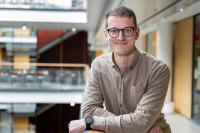Fighting blood diseases with software and deep learning

A new kind of software combining imaging, big data analysis and deep learning can be used to study blood diseases. Hematoscope Oy's solution combines cutting-edge research and business thinking.
The understanding, monitoring and diagnosis of haematological diseases are changing thanks to new technologies. For other diseases, methods based on algorithms and software have already been used. In blood diseases, Hematoscope Oy's research and business project is reportedly the first of its kind in the world.
"In collaboration with HUS, we have developed a software that could automatically analyse the composition and morphology of bone marrow and blood samples. The software consists of advanced algorithms developed using a large image bank of microscopic images. Our algorithm still needs further refinement, but we are soon entering the clinical trials phase. Then we will find out how well our software supports patient work," says Oscar Brück, a research physician at HUS and co-founder and CEO of Hematoscope Oy.
The Instrumentarium Science Foundation awarded Hematoscope Oy a 50 000-euro SILMU grant in February 2023. It will allow the company to hire programmers to use previously developed algorithms in the Hematoscope software and use the data they generate for patient care.
From research to product
Brück, who graduated as a doctor in 2016 and received his PhD in haematological immunology in 2021, also leads the haematology research group at the HUS Cancer Centre and Diagnostic Centre. According to Brück, the research was intended from the very outset to be as close as possible to practice and patient work. At the same time, he saw that research could also lead to business. However, the algorithms that identify and classify cells from microscopic images should first be improved. The software would also need to be certified as a medical device before it could be used in clinical practice.
"A friend of mine died of cancer a few years ago. I was really frustrated to discover how difficult it was as a researcher to influence the treatment decisions of an individual patient. I wanted to use my expertise to solve two key problems in the field of blood diseases: a shortage of diagnostic staff and the individualisation of treatments. Development work takes time, a good team and funding. People in my research team develop algorithms and machine learning methods and publish results for other researchers to use. Instead, the company builds software that exploits and certifies algorithms for clinical work. These require specific skills and resources that are better suited to the company," says Brück.
Machine learning to support doctors
The algorithm developed by the company uses a subset of machine learning called "deep learning". This technique is particularly suitable for image recognition and analysis. Algorithms identify different cells in images and determine their properties mathematically. When the pixel resolution of the images is high enough, the software can tell you what kind of cell it is and how it relates to the patient's disease or treatment response.
"We train the algorithm with supervised learning, which means we tell it in detail, picture by picture and cell by cell, what it needs to learn. It takes a lot of time, but our models are of such high quality and reliability. The healthcare professional is informed about the result of the algorithm and can see how the algorithm works and how reliable the result is. The user and the machine work together, supporting each other," Brück points out.
Within the next ten years, machine learning will become part of doctors' everyday practice, according to Brück. Algorithms will then be increasingly used for diagnosis, treatment decisions and documentation of medical records. Hospitals have to invest in computing power to keep hundreds of algorithms running in real time. According to Brück, Hematoscope has already developed several solutions to make the algorithms more efficient. They enable cost-effective use of the software in the HUS telecommunications network. The company will later purchase its own secure server for its software.
Medicine and research or business?
The SILMU grant from the Instrumentarium Science Foundation is very valuable to Hematoscope's activities. It allows the company to hire programmers to bring the software even closer to the requirements of the targeted CE certification. Part of the money will also go towards the purchase of the computer server mentioned earlier. The grant is the company's first source of external funding. Brück believes that the grant could also open the way to other donors and financial instruments.
"Doctors are typically more researchers than business people. Of course, there is business thinking in the field, but often medical research is commercialised by someone other than a doctor or a health authority. I have thought that at some point, when my project is much further along, I could prepare a guide on how to commercialise a medical invention. I would have been in desperate need of one myself," Brück laughs.
Text by Kai Tarkka / Viestintäpalvelu Taika Oy
Photo by Houman Auriell
